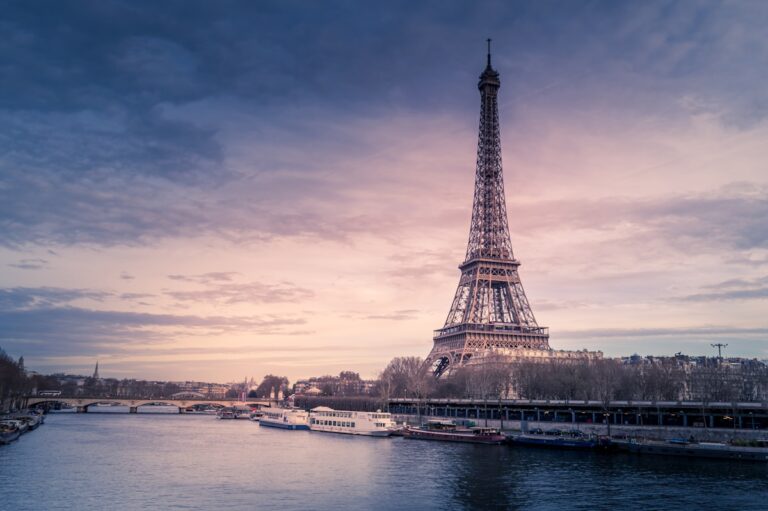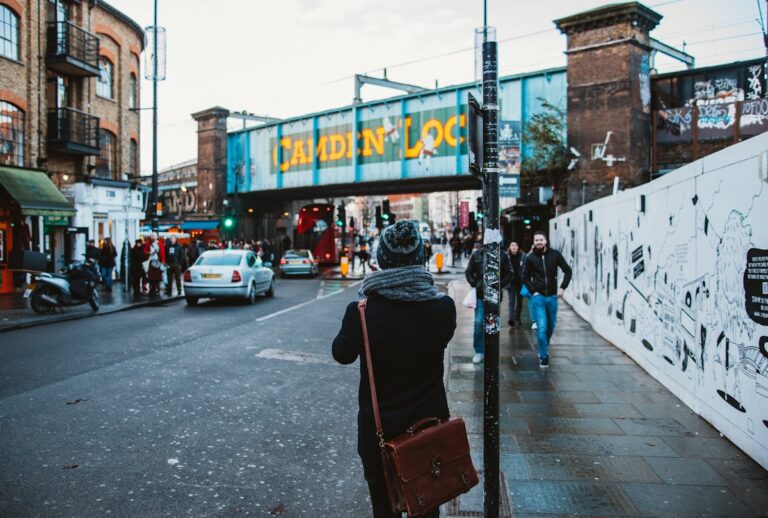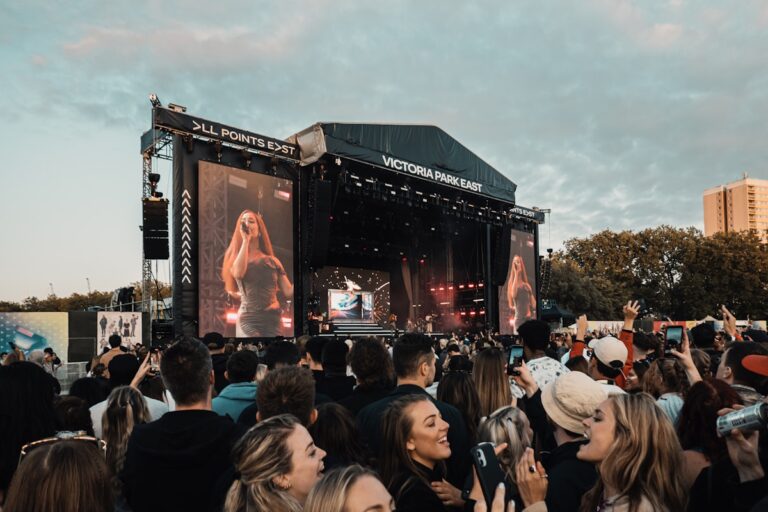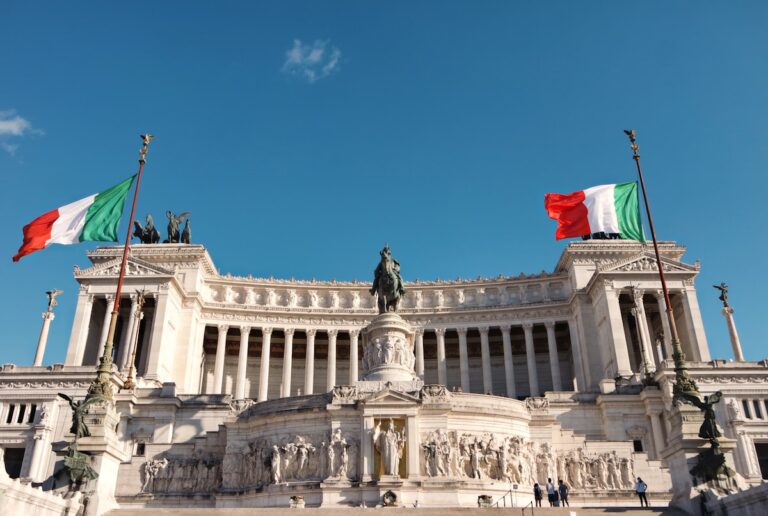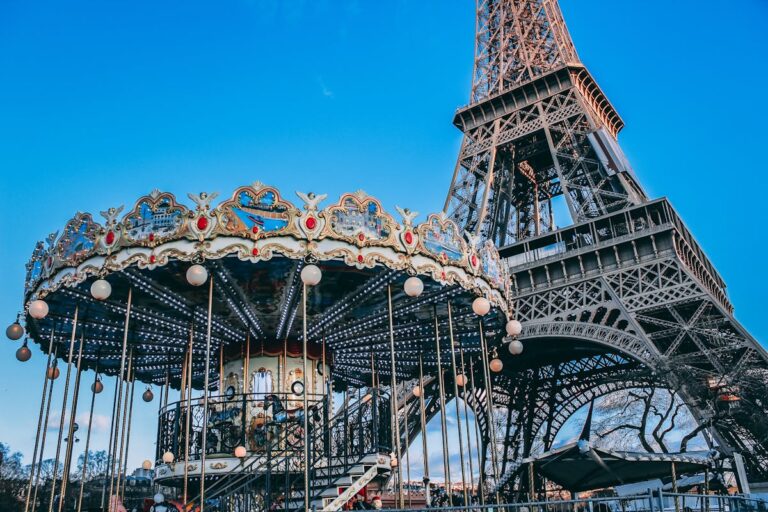Exploring 25+ Most Iconic and Historical Landmarks in Paris
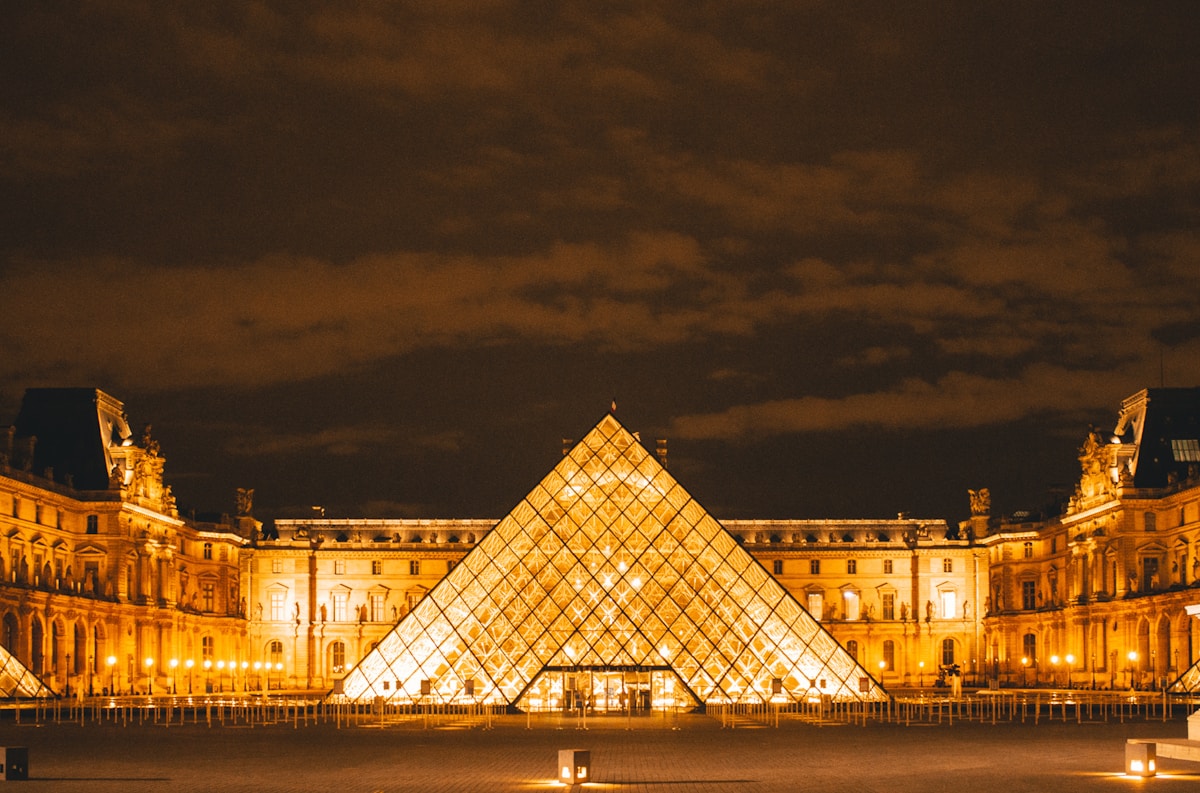
Paris’ most iconic landmarks offer a journey through its architectural and historical evolution. Notre-Dame de Paris, a Gothic masterpiece from 1163, epitomizes medieval innovation.
The Panthéon, built between 1758 and 1790, blends neoclassical and Gothic styles, enshrining famous French figures. The Arc de Triomphe, completed in 1836, symbolizes French military triumphs.
The late 19th-century Basilica of the Sacred Heart stands out with its Romano-Byzantine design.
Early 20th-century gems like the Centre Pompidou and Bibliothèque François-Mitterrand showcase modern architectural ingenuity.
Each structure highlights different eras, inviting exploration of Paris‘ rich cultural and architectural heritage.
A Guide to GetOutTrip's Favorite Historical Landmarks in Paris
Hide- Paris is known as the City of Lights, with a history dating back thousands of years, and its Latin name, Lutetia, translates to Midwater-Dwelling 🌆
- Notre-Dame de Paris is a Gothic cathedral that has been the city's cathedral since the Middle Ages, featuring a framework of flying buttresses and a revolutionary engineering technique ⛪️
- The Hôtel de Soubise is a city mansion built for the prince and princess de Soubise, featuring a huge courtyard, twin colonnades, and statues representing the four seasons 🏰
- The Panthéon is a Neoclassical monument and an outstanding example of Enlightenment architecture, featuring a Greek cross plan and a central dome 🏛️
- The Arc de Triomphe is one of the world's largest triumphal arches, commissioned by Napoleon I to commemorate his victories, featuring four main allegorical sculptural reliefs 🏆
- The Madeleine is a Neoclassical temple built as a church, featuring a grand entrance, Corinthian columns, and a pediment sculpture of Mary Magdalene 🕊️
- The Palais Garnier is a sumptuous and flamboyant 19th-century Neo-Baroque opera house, featuring a grand staircase, marble friezes, and gilded moldings 🎭
- Castel Béranger is an Art Nouveau building designed by Hector Guimard, featuring a varied facade, irregular windows, and a unique interior stairwell 🏠
- La Ruche is a circular structure built as a temporary wine pavilion, later transformed into a complex of artists' studios, exhibition space, and a theater 🎨
- The Hôtel Guimard is a unified masterpiece of harmonious integration between architecture and decoration, featuring oval room interiors and unique pieces of furniture 🏡
- The Théâtre des Champs-Élysées is a renowned theater featuring a frame of reinforced concrete, a paired shallow arches spanning the auditorium, and an Art Nouveau staircase 🎭
- The Maison à Gradins Sportive is an apartment block designed by Henri Sauvage and Charles Sarazin, featuring a tiered structure, balconies, and a nautical appearance 🏊♀️
- The Basilique du Sacré Coeur is a Roman Catholic basilica built on the summit of Montmartre, featuring a white travertine stone structure, a dome, and a panoramic view 🏔️
- The Grande Mosqué de Paris is a mosque built in the Mudéjar style, featuring a square minaret, a prayer room, and a courtyard surrounded by finely carved colonnades 🕊️
- The Grand Rex is an Art Deco cinema featuring a ziggurat crown, ocean-liner styling, and an opulent auditorium 🍿
- The Maison de Verre is a modern house designed by Pierre Chareau, featuring a unique volume, abstraction, geometry, and authenticity of materials 🏠
- The Centre Pompidou is a contemporary art museum featuring a colorful exterior, a steel exoskeleton structure, and a long, snaking, glass tube-enclosed escalator 🎨
- The Musée d'Orsay is a museum built in a former railway station, featuring a glass awning, cast-iron pillars, and stucco decorations 🚂
- The Institut du Monde Arabe is a cultural center featuring a geometrical steel and glass figure, a curving facade, and a screen composed of light-sensitive sun-control diaphragms 🌐
- The Pyramide is a glass pyramid built as part of the Louvre Museum, featuring a striking shape, fountains, and pools 🏯
- The Opéra de la Bastille is a modern opera house featuring a transparent and featureless facade, black granite floors, and a democratic invitation to enter the theater 🎭
- La Grande Arche de la Défense is a modern triumphal arch featuring a prestressed concrete structure, glass, granite, and white Carrara marble 🏛️
- The Très Grande Bibliothèque is a library featuring a simple and pure design, a secluded garden, and four book-shaped corner storage towers 📚
- The Maison Vegetale is a social housing block featuring a vertical urban garden, green bamboo plants, and a unique variegated two-tone concrete appearance 🌿
- The Quai Branly Museum is a museum featuring a pier-like structure, a horizontal row of protruding cubes, and a garden separated from the Seine by a vertical wall of vegetation 🌴
- The Fondation Louis Vuitton is a contemporary art gallery featuring a series of stacked boxes, overlapping "sails" of glass, and a subterranean undercroft 🎨
As part of our comprehensive Paris travel guide, we will explore the most iconic and historical landmarks in Paris which are suitable for any trip type, from family trip to Paris to backpacking Paris.
The 25+ Must-Visit Iconic and Historical Landmarks in Paris
![]()
Paris, a city steeped in history and culture, boasts an array of must-visit iconic landmarks that narrate its rich past.
From the medieval grandeur of Notre-Dame de Paris to the opulent 18th-century Hôtel de Soubise, these sites offer a chronological journey through architectural marvels.
Find out how many days are enough to explore all historical landmarks in Paris with our AI Trip Length Guide. It’s totally free. Try it out now!
Further enriching the historical landscape are the Panthéon, the Arc de Triomphe, and the Church of St. Mary Magdalene, each contributing uniquely to Paris’s storied heritage.
Notre-Dame de Paris
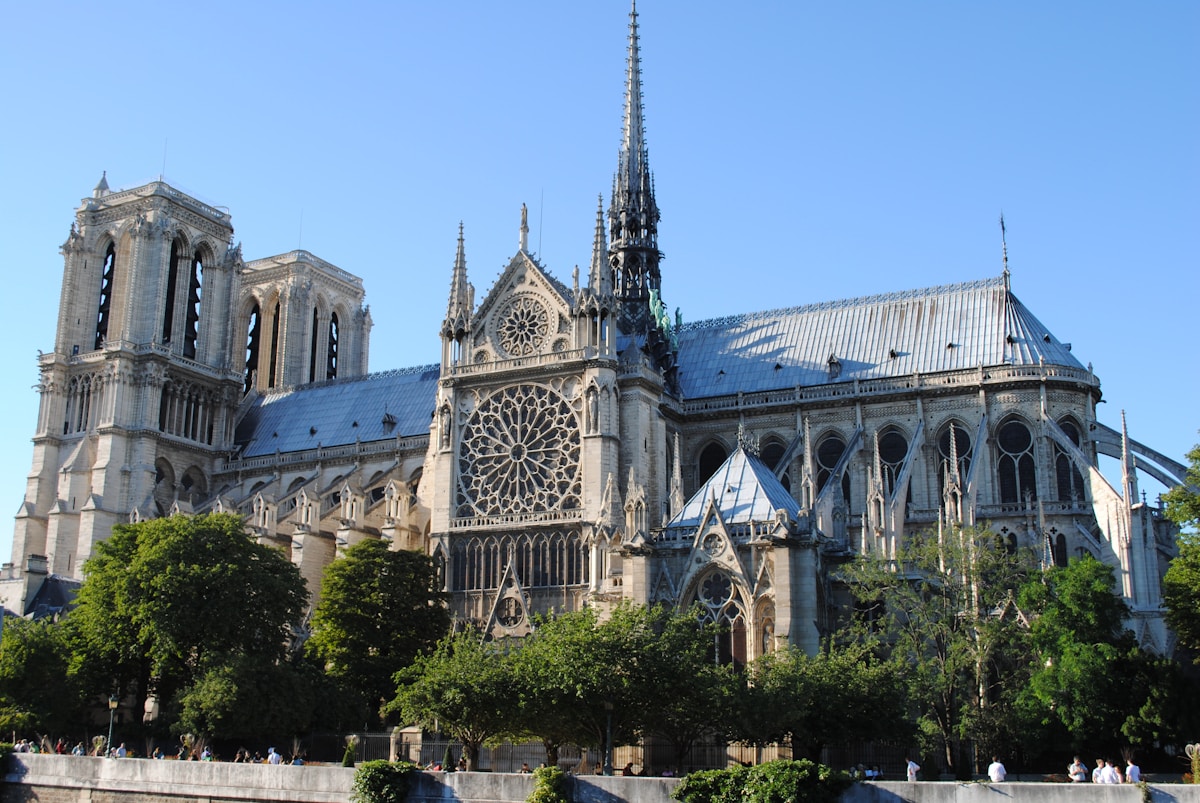
Standing as a masterpiece of French Gothic architecture, Notre-Dame de Paris has witnessed nearly nine centuries of history and remains one of the most revered symbols of cultural heritage in the heart of the French capital.
Among the most prominent historical sites in Paris, this cathedral has not only shaped the skyline but also the spirit of the city. Constructed between 1163 and 1345, Notre-Dame de Paris exemplifies the quintessence of medieval design, characterized by its innovative use of flying buttresses, grand rose windows, and intricate sculptures.
To understand its significance, consider the following key aspects:
- Architectural Innovation: The use of flying buttresses was groundbreaking, allowing for higher walls and larger windows, which became defining features of Gothic architecture in Paris.
- Historical Events: Notre-Dame has been the backdrop for pivotal moments, such as the coronation of Napoleon Bonaparte and the beatification of Joan of Arc.
- Cultural Influence: Victor Hugo’s 1831 novel, ‘The Hunchback of Notre-Dame,’ played a vital role in preserving the cathedral, highlighting its importance among famous Paris buildings.
- Restoration Efforts: Following the devastating fire in April 2019, global efforts have been mobilized to restore this jewel among landmarks in Paris, underscoring its enduring legacy.
Hôtel de Soubise
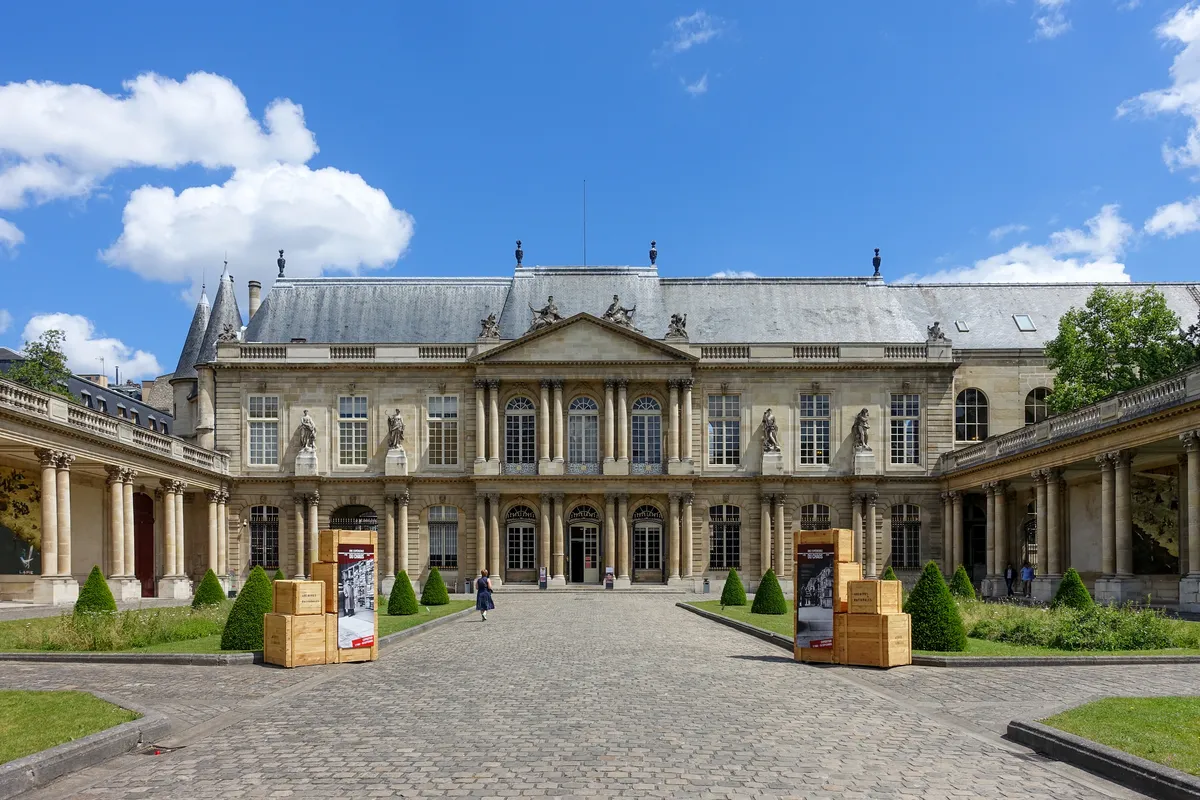
Nestled in the Marais district, the Hôtelde Soubise serves as a quintessential example of French baroque architecture and an invaluable repository of historical and cultural artifacts.
Originally constructed in 1371, the building underwent significant transformation in the early 18th century under the direction of architect Germain Boffrand. This architectural marvel embodies the artistic opulence and intricate design characteristic of old Paris.
The hôtel de soubise stands as one of the most significant Paris historical sites, attracting visitors with its ornate interiors and historical prominence. Once the private residence of the princely Soubise family, it now houses part of the National Archives of France, making it a crucial center for historical research.
| Feature | Description |
|---|---|
| Location | Marais district, Paris |
| Architectural Style | French Baroque |
| Transformation Period | Early 18th Century |
| Current Function | National Archives of France |
| Historical Significance | Residence of the Soubise family, archival center |
The Hôtelde Soubise serves as a reflection of the enduring legacy of French buildings and their role in preserving history. Its evolution from a noble residence to a scholarly institution underscores its importance among historical places in Paris. For those seeking to explore the rich tapestry of Parisian history, the Hôtelde Soubise is an indispensable visit.
Panthéon
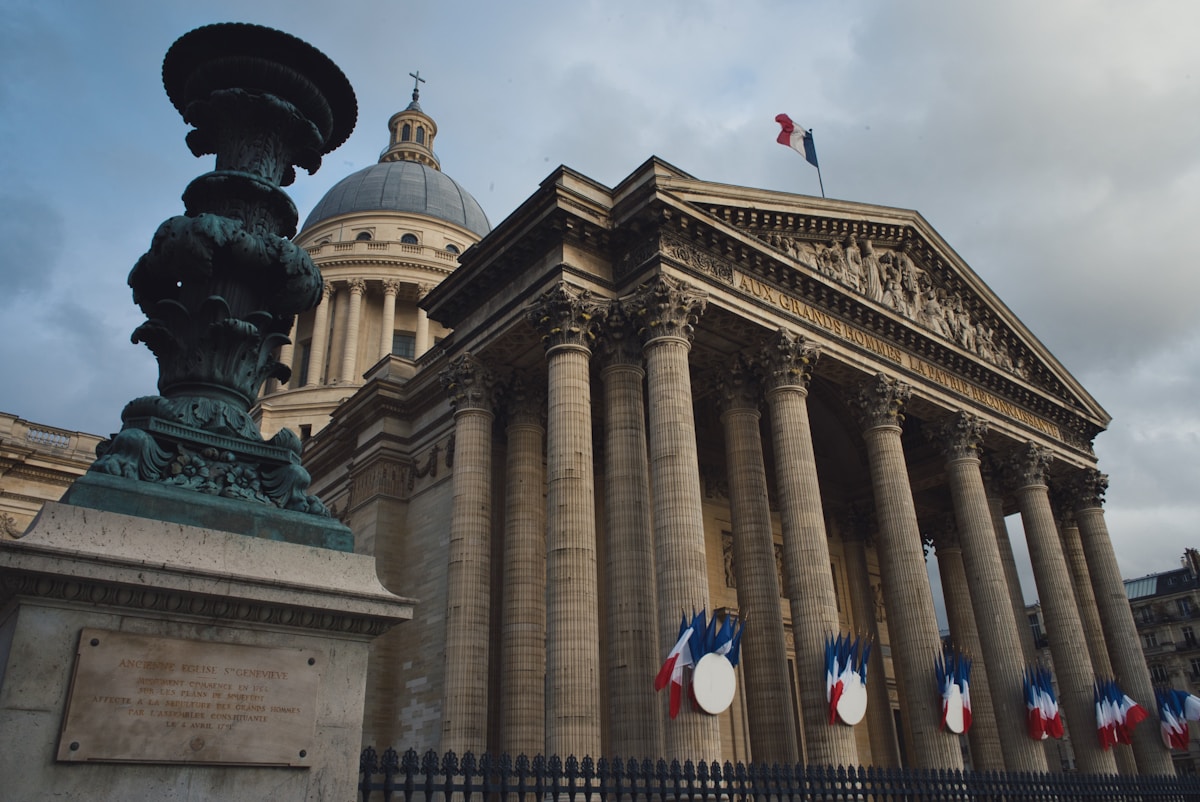
As we move from the opulent confines of the Hôtel de Soubise, our journey through Parisian history brings us to the Panthéon, a monumental edifice that epitomizes the neoclassical architectural style and stands as a tribute to France’s reverence for its distinguished citizens.
Originally conceived as a church dedicated to St. Genevieve, the Panthéon evolved into one of the most famous monuments in Paris, housing the remains of eminent French figures such as Voltaire, Rousseau, Victor Hugo, and Marie Curie.
Constructed between 1758 and 1790, the Panthéon showcases a blend of Gothic and neoclassical elements, reflecting the changeable architectural trends of the era. Its majestic dome and Corinthian columns offer a striking visual experience, while its interior, adorned with murals and sculptures, narrates pivotal moments in French history.
To truly appreciate the Panthéon’s significance, consider the following:
- Architectural Design: Designed by Jacques-Germain Soufflot, it harmoniously merges classical Greek and Roman influences.
- Historical Role: Shifted from a church to a mausoleum post-Revolution, symbolizing France’s secular shift.
- Cultural Importance: Hosts tombs of luminaries, making it a place of pilgrimage for history enthusiasts.
- Panoramic Views: Offers breathtaking views of Paris from its colonnade, enhancing its status among famous buildings in Paris.
This landmark remains a reflection of France’s architectural grandeur and historical reverence.
Arc de Triomphe
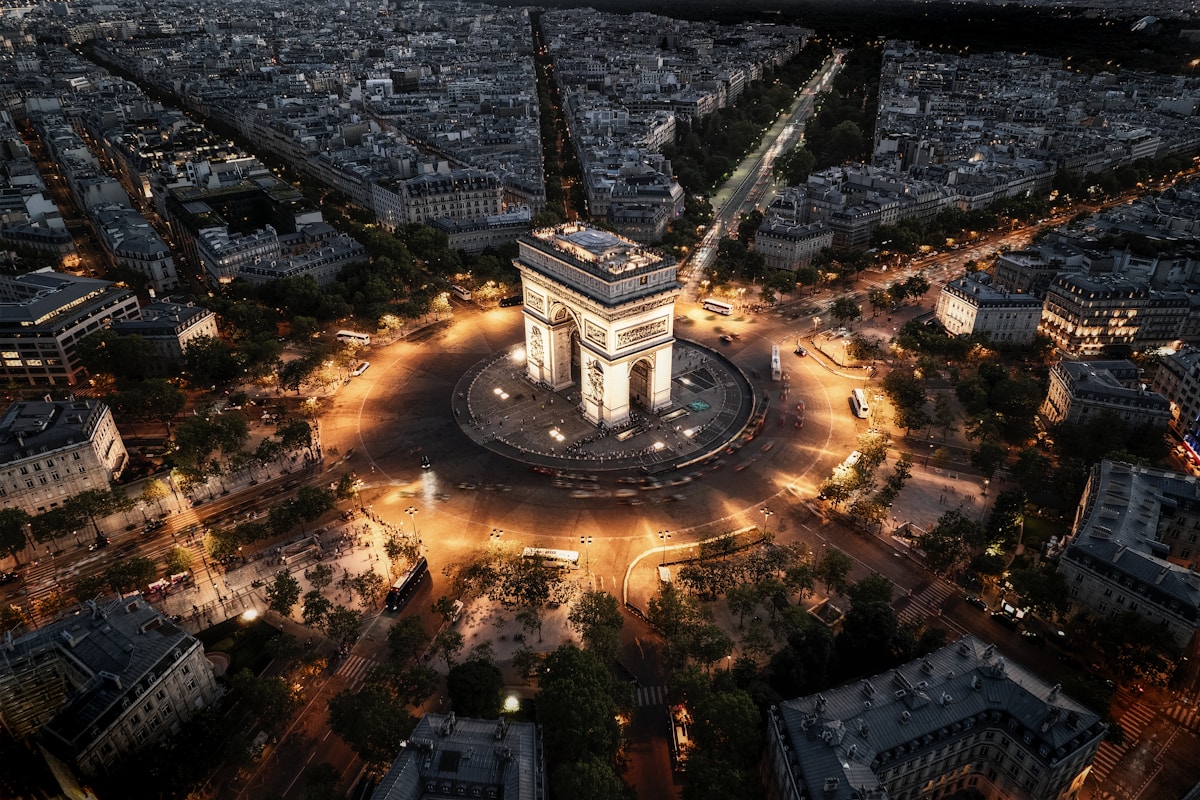
Dominating the western end of the Champs-Élysées, the Arc de Triomphe serves as a monumental tribute to France’s military prowess and historical resilience.
Commissioned by Napoleon Bonaparte in 1806 following his victory at Austerlitz, this iconic Paris building encapsulates the essence of French patriotism. Standing at 50 meters tall, its grandeur is both awe-inspiring and symbolic, representing the sacrifices of French soldiers throughout history.
The Arc de Triomphe, one of the most famous buildings in Paris, was completed in 1836 under the reign of King Louis-Philippe. It features detailed reliefs and engravings depicting pivotal battles and military triumphs.
The names of generals and soldiers are etched into the stone, immortalizing their contributions. Beneath the arch lies the Tomb of the Unknown Soldier, established in 1921, which includes an eternal flame in honor of the unidentified soldiers who perished during World War I.
Unlike the oldest buildings in Paris, the Arc de Triomphe stands as a relatively recent addition to the city’s storied architectural landscape. However, it has quickly become one of the most famous buildings in France, embodying the nation’s enduring spirit and commitment to remembering its past.
Church of St. Mary Magdalene
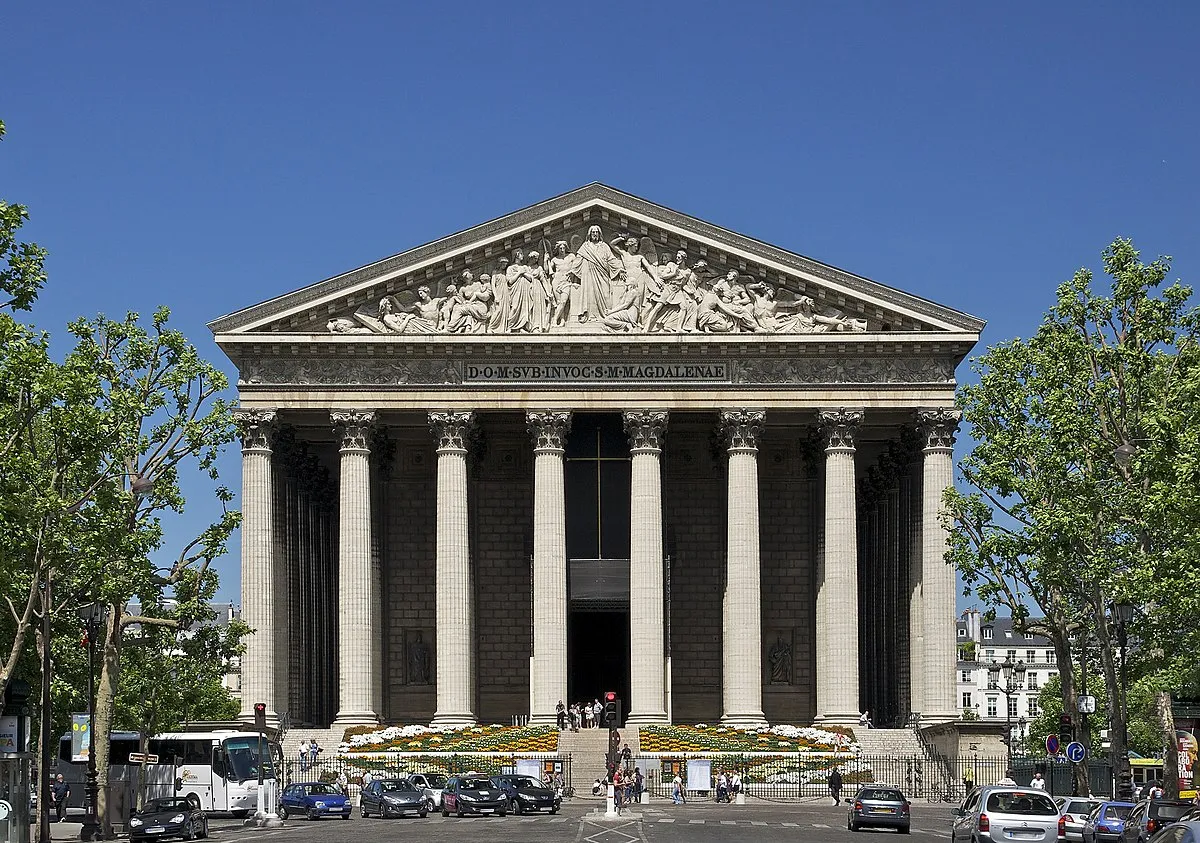
Frequently regarded as an architectural masterpiece, the Church of St. Mary Magdalene, commonly known as La Madeleine, stands as a symbol of Paris’s rich religious and cultural heritage. Located in the 8th arrondissement, this neoclassical edifice was commissioned by Napoleon Bonaparte in 1806 and completed in 1842.
Its design, reminiscent of a Greek temple, features a grand portico adorned with 52 Corinthian columns, each standing 20 meters tall.
La Madeleine’s historical significance is multifaceted, as it has shifted through various intended purposes since its inception. Initially conceived as a temple to the glory of Napoleon’s army, it later morphed into a Catholic Church under the reign of Louis XVIII. The interior is equally grand, with opulent frescoes and an imposing high altar.
To appreciate its full context, consider the following points:
- Historical Evolution: Shifted from a temple of glory to a Catholic church.
- Architectural Style: Exemplifies neoclassical design with Greek temple influences.
- Cultural Symbol: Reflects Paris’s dynamic religious and political history.
- Artistic Interior: Features intricate frescoes and sculptures.
La Madeleine remains a must-visit for those seeking to understand the nuanced interplay between Paris’s religious traditions and its fluctuating political landscape.
Palais Garnier
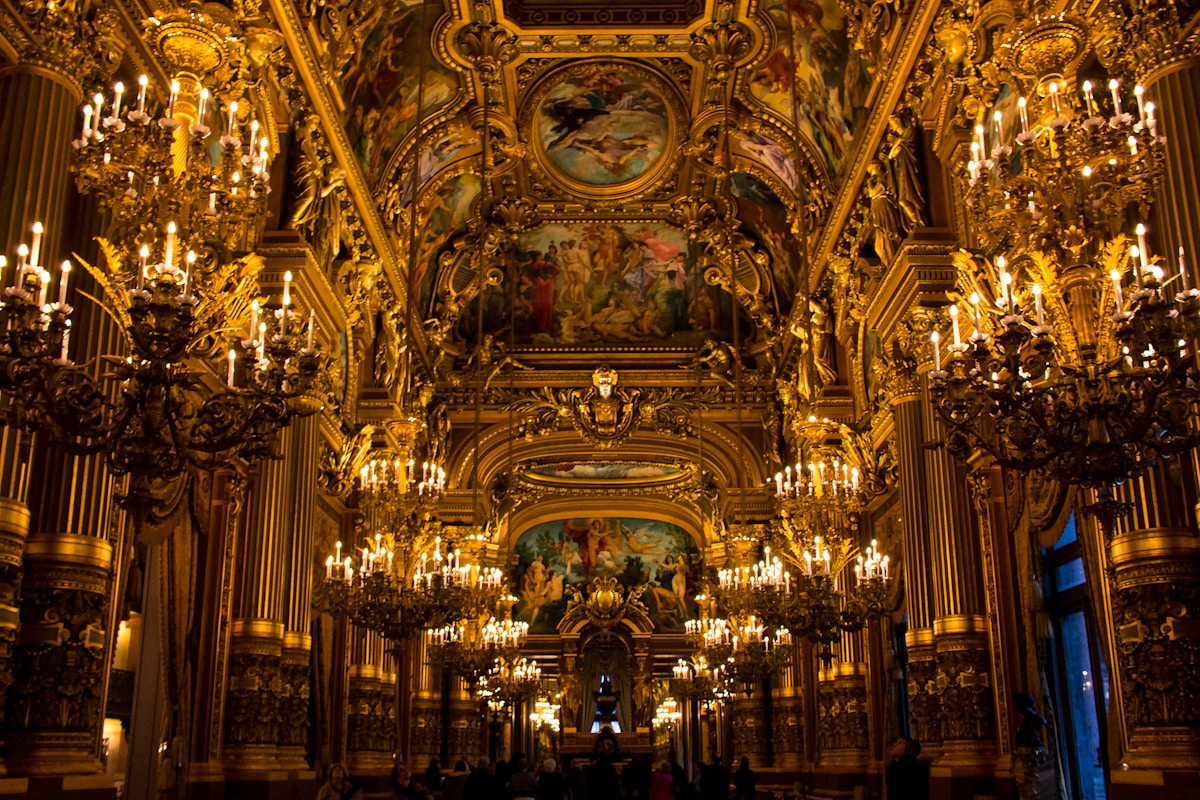
Similarly embodying Paris’s architectural grandeur and cultural richness, the Palais Garnier stands as a quintessential example of opulent 19th-century design and remains one of the city’s most celebrated landmarks.
Commissioned by Emperor Napoleon III and designed by Charles Garnier, this Paris Opera House was completed in 1875 after a 15-year construction period. Its eclectic and lavish Beaux-Arts style is characterized by intricate sculptures, grand staircases, and sumptuous interiors adorned with gold leaf, marble, and frescoes.
The exterior of the Palais Garnier is equally breathtaking, featuring elaborate ornamentation including the famed bronze “L’Art du Chant” and “L’Art de la Musique” sculptures. The grand façade, with its Corinthian columns and richly decorated pediment, commands attention and admiration.
The building’s crowning glory is the central dome, which is topped by a statue of Apollo holding a lyre, symbolizing the arts.
Inside, the grand foyer and the grand staircase are masterpieces of design, offering a visual feast that mirrors the opulence of the performances held within. The auditorium, with its 1,979 velvet seats and Marc Chagall’s ceiling painting, provides a setting that enhances the operatic and balletic experiences.
The Palais Garnier, consequently, epitomizes the cultural and architectural sophistication of Paris.
Castel Béranger
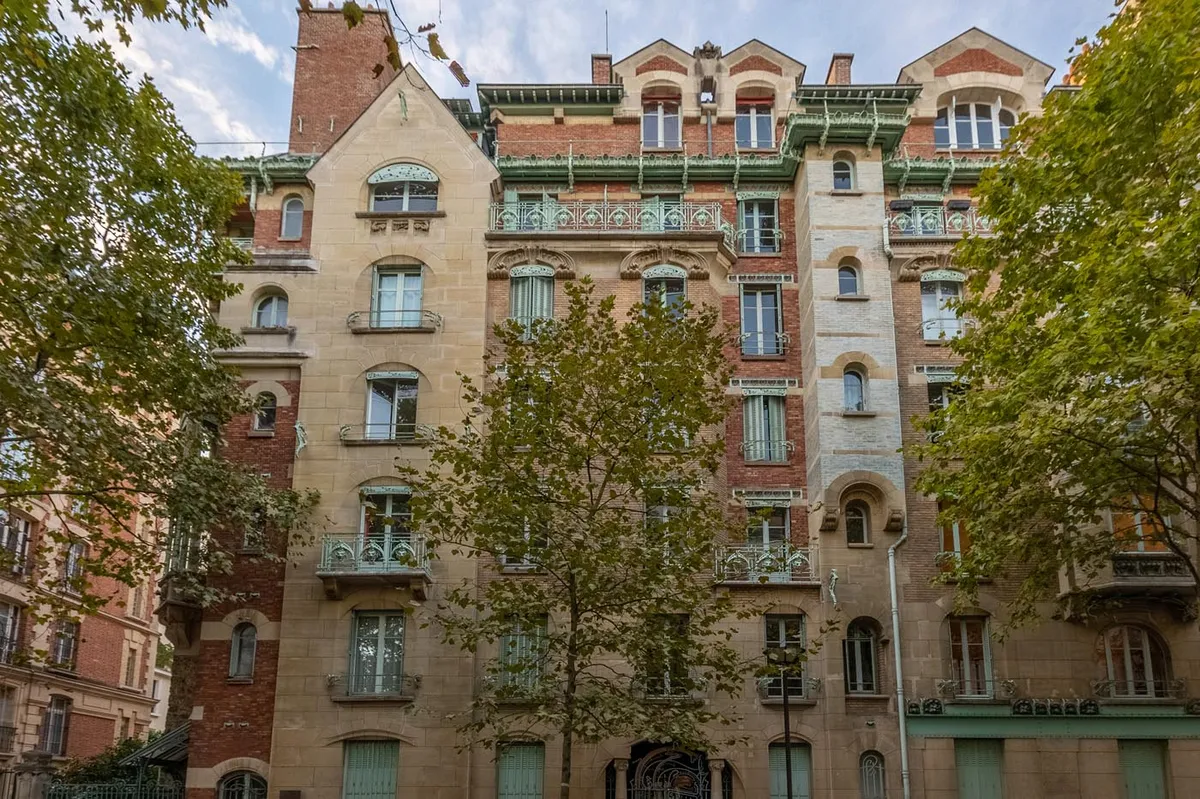
Nestled in the 16th arrondissement, Castel Bérranger stands as a striking embodiment of Art Nouveau architecture, designed by the visionary architect Hector Guimard and completed in 1898.
This residential building marked a significant departure from the conventional architectural norms of the time, introducing a fluidity and organic aesthetic that captivated the Parisian imagination.
Several aspects make Castel Bérranger a must-visit landmark:
- Architectural Innovation: Guimard’s use of asymmetry, flowing lines, and natural forms broke away from the rigid symmetry of previous architectural styles, setting a new direction for urban design.
- Decorative Elements: The facade features intricate ironwork, ceramic tiles, and sculptural details that exemplify the lavish ornamentation typical of Art Nouveau.
- Historical Significance: As one of the first Art Nouveau buildings in Paris, Castel Bérranger played a pivotal role in popularizing the movement, influencing subsequent architectural trends in the city.
- Cultural Impact: The building won first prize in the 1898 façade competition organized by the City of Paris, cementing its status as an architectural icon.
In essence, Castel Bérranger is not merely a building but a historical milestone that continues to inspire and attract enthusiasts of architectural freedom and innovation.
La Ruche Studios

La Ruche studios, established in 1902 in the 15th arrondissement of Paris, serve as a vibrant symbol of the city’s rich artistic heritage, having provided a creative haven for numerous avant-garde artists throughout the 20th century.
The studio complex, whose name translates to ‘The Beehive,’ was originally designed by sculptor Alfred Boucher to foster an environment of artistic collaboration and innovation.
Boucher repurposed the circular structure from the remnants of a wine rotunda used at the 1900 Paris Exposition, creating an eclectic space that would attract burgeoning talent.
La Ruche became a crucible for artistic experimentation, housing luminaries such as Fernand Léger, Amedeo Modigliani, and Chaim Soutine. This melting pot of creativity was instrumental in the development of significant artistic movements, including Cubism and Surrealism.
The studios offered not only physical space but also an inspiring community where ideas could be exchanged freely, fostering artistic freedom and expression.
Despite periods of decline and neglect, La Ruche has endured, evidence of its historical and cultural significance. Today, it remains a cherished landmark, continuing to support artists and embodying the enduring spirit of Parisian creativity and freedom.
Rue Franklin Apartments
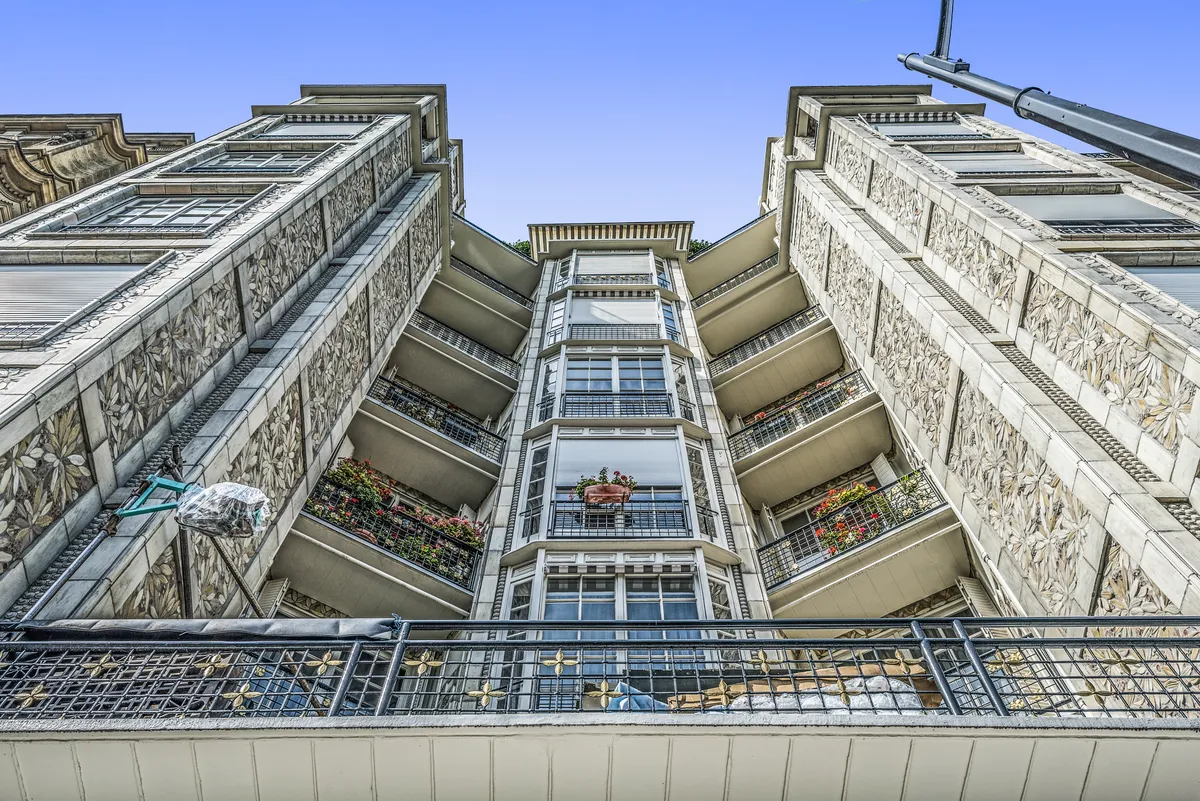
The Rue Franklin apartments, designed by the renowned architect Auguste Perret in 1903, stand as a pioneering example of early 20th-century modernist architecture in Paris.
This groundbreaking building is credited with being one of the first residential structures to utilize reinforced concrete, a material that would come to define modern construction techniques.
Perret’s innovative use of concrete provided remarkable flexibility in form and function, which allowed for an unprecedented level of structural and aesthetic freedom.
Key features of the Rue Franklin apartments include:
- Innovative Use of Reinforced Concrete: This material allowed for larger windows and open floor plans, enhancing natural light and spatial fluidity.
- Façade Design: The building’s façade integrates ceramic tiles and floral motifs, blending traditional Parisian aesthetics with modernist principles.
- Structural Integrity: Reinforced concrete offered superior strength, making the structure more resilient and durable compared to conventional methods of the era.
- Architectural Influence: Perret’s design influenced subsequent generations of architects, promoting the acceptance of modernist principles in urban residential architecture.
In the context of Parisian architecture, the Rue Franklin apartments represent a significant turning point, marrying technological advancement with artistic expression.
This landmark remains a proof of the visionary foresight of Auguste Perret and his contribution to the architectural landscape of Paris.
Hôtel Guimard
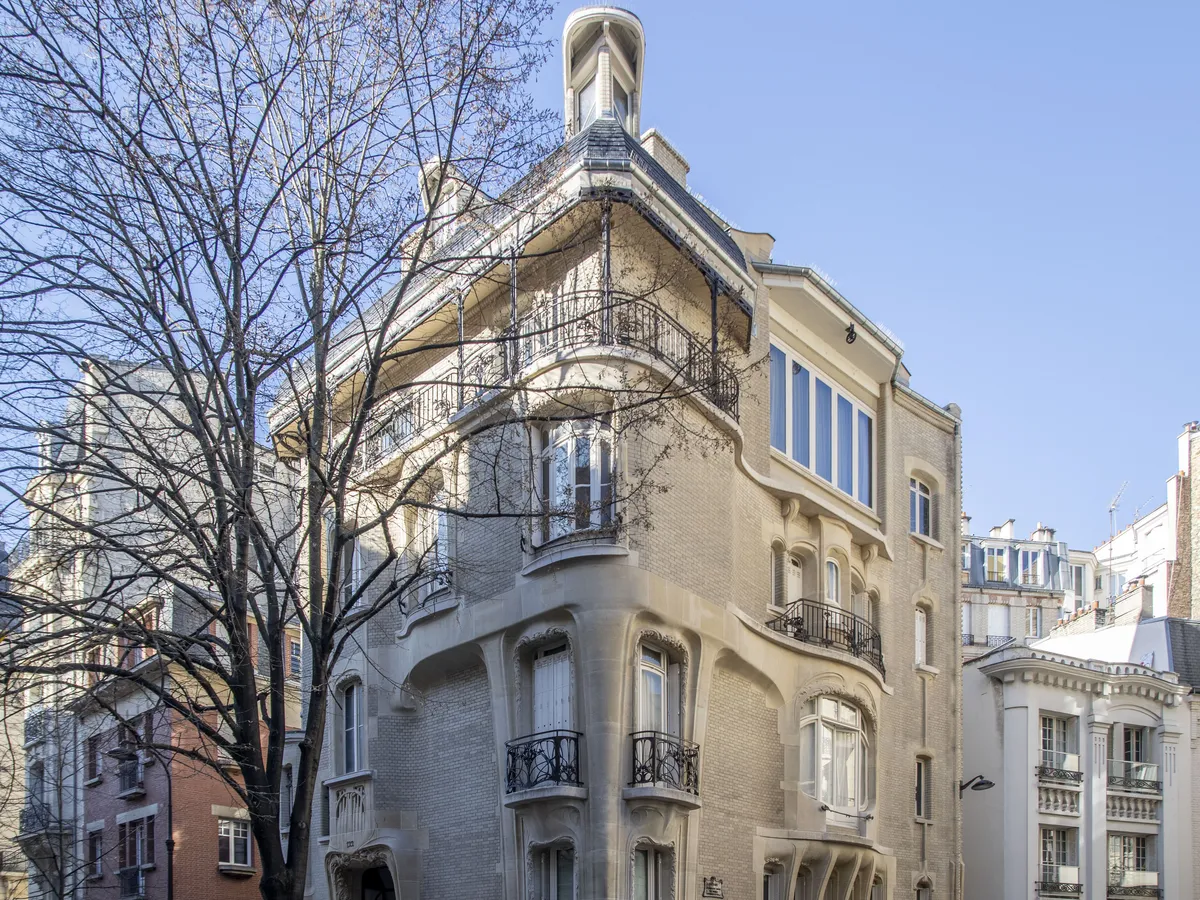
Often celebrated for its striking Art Nouveau design, the Hôtel Guimard exemplifies Hector Guimard‘s masterful integration of organic forms and innovative architectural elements, making it an essential stop for anyone exploring Paris’s rich historical landmarks.
Constructed between 1909 and 1912, this private mansion at 122 Avenue Mozart in the 16th arrondissement stands as a reflection of Guimard’s visionary approach to architecture.
Guimard, renowned for his work on the Paris Métro entrances, applied similar principles to the Hôtel Guimard, emphasizing fluidity and natural forms. The use of curvilinear lines, floral motifs, and asymmetrical shapes in both the exterior and interior demonstrates his commitment to creating harmony between structure and nature.
The façade, adorned with intricate wrought-iron balconies and sinuous stone carvings, draws the eye and evokes a sense of movement and life.
Inside, the attention to detail continues with bespoke furniture, decorative glass, and custom fixtures, all designed by Guimard himself. The holistic design underscores a philosophy where architecture and interior design converge seamlessly.
For those seeking an immersive experience in Art Nouveau, the Hôtel Guimard (also read: Best Hotels in Paris With Eiffel Tower View) offers a profound glimpse into the era’s innovative spirit and aesthetic.
Théâtre des Champs Elysées
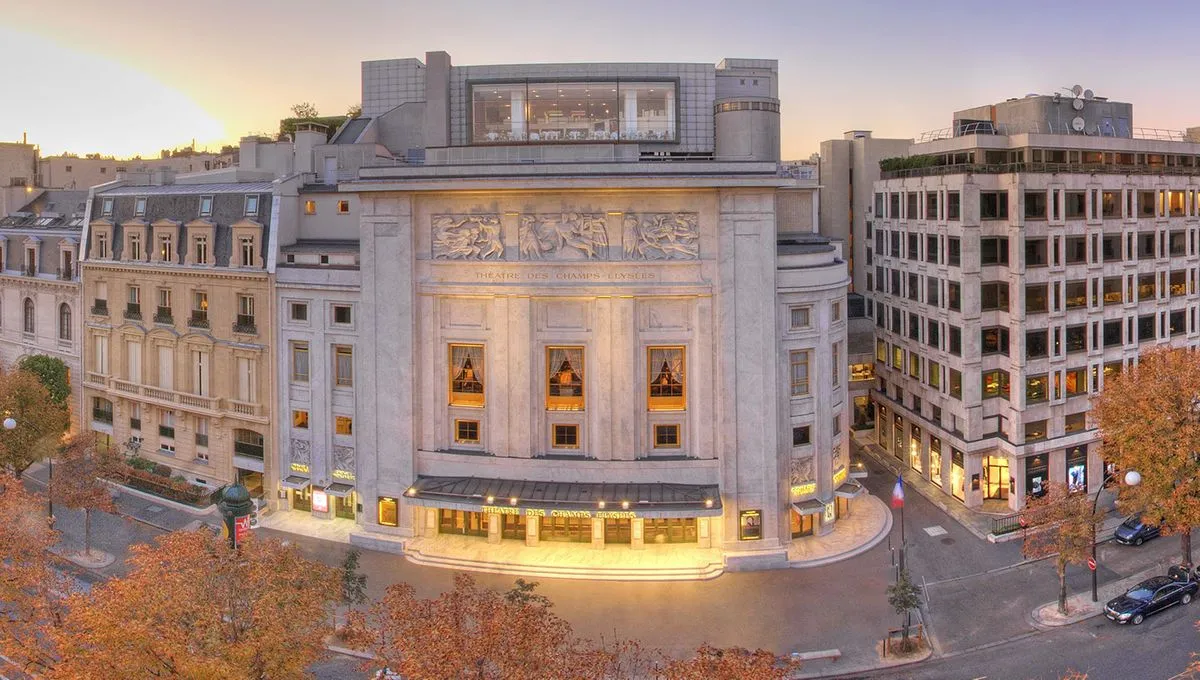
Situated on Avenue Montaigne, the Thétre des Champs Elysées stands as a tribute to early 20th-century architectural innovation and cultural ambition, blending neoclassical and Art Deco elements under the guidance of architect Auguste Perret.
Completed in 1913, this landmark broke away from traditional opera house designs by incorporating reinforced concrete, a pioneering material at the time. Envisioned as a multidisciplinary venue, it has hosted an array of performances, from orchestral concerts to ballets.
The theatre’s history is marked by several key milestones:
- Inaugural Performance: The opening concert in 1913 featured the works of Claude Debussy and Igor Stravinsky, setting a high artistic standard.
- Architectural Significance: Its use of reinforced concrete was revolutionary, influencing modern architectural practices.
- Cultural Impact: Over the decades, it has been a stage for world-renowned artists, including Sergei Diaghilev’s Ballets Russes.
- Restoration: Extensive renovations in the late 20th century maintained the preservation of its original aesthetic while upgrading its facilities.
Apartments at 26, Rue Vavin
Located in the heart of Montparnasse, the apartments at 26, rue Vavin represent a quintessential example of early 20th-century Parisian residential architecture, blending Art Nouveau and modernist influences under the vision of architect Henri Sauvage.
Constructed between 1912 and 1914, these apartments reflect an era of architectural innovation and social transformation, embodying the progressive spirit of pre-World War I Paris.
Henri Sauvage’s design is distinctively characterized by its terraced façade, an innovative approach aimed at optimizing natural light and ventilation for each unit.
This design choice not only enhanced the living conditions but also stood as a demonstration of Sauvage’s forward-thinking ethos.
The façade is adorned with intricate ceramic tiles, a hallmark of Art Nouveau aesthetics, while the building’s structural honesty nods to burgeoning modernist principles.
The apartments at 26, rue Vavin are not merely a residential ensemble but a historical narrative encapsulating the cultural dynamism of Montparnasse during the Belle Époque.
As a hub for artists, writers, and intellectuals, this area was fertile ground for artistic experimentation and social discourse, making these apartments an essential link in the architectural and cultural tapestry of Paris.
Basilica of the Sacred Heart of Christ
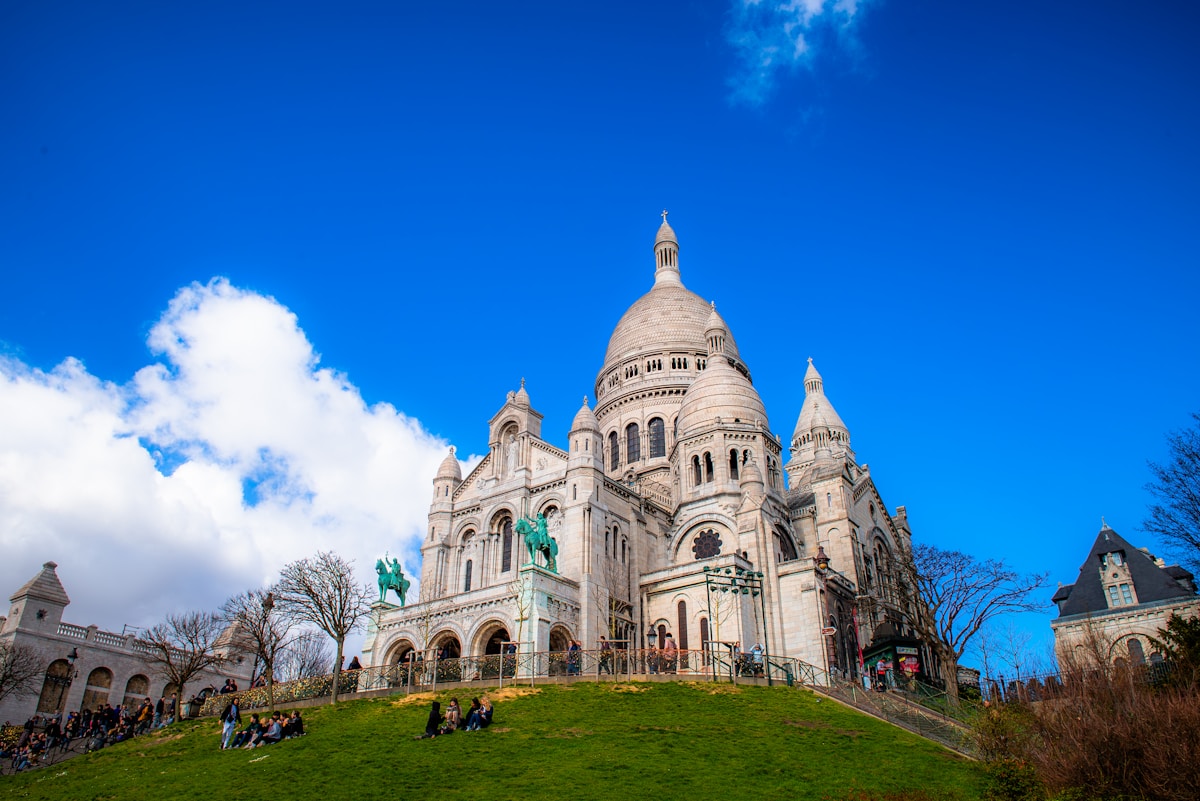
The Basilica of the Sacred Heart of Christ, perched atop the highest point in the city on Montmartre Hill, stands as a monumental tribute to both religious devotion and the socio-political milieu of late 19th-century Paris.
Commissioned in 1875, its construction was a response to the Franco-Prussian War and the subsequent Paris Commune, symbolizing a penitent nation’s enduring faith and resilience.
Designed by Paul Abadie, the basilica’s Romano-Byzantine architecture is distinctive, featuring a prominent white travertine façade that gleams in the sunlight, a stark contrast to the surrounding urban landscape.
The interior, adorned with a grand mosaic of Christ in Majesty, invites contemplation and reverence.
Visitors to the Basilica are often drawn to its panoramic views of Paris, accessible via a climb to the dome. The site offers a unique vantage point to appreciate the city’s sprawling beauty.
To fully appreciate the Basilica’s significance, consider the following:
- Historical Context: Built post-1871 as a national vow after Franco-Prussian defeat.
- Architectural Significance: Exemplifies Romano-Byzantine style.
- Cultural Impact: Symbol of faith and redemption.
- Tourist Attraction: Offers unrivaled views of Paris.
These facets collectively underscore the Basilica’s esteemed place in Parisian history and culture.
Paris Great Mosque
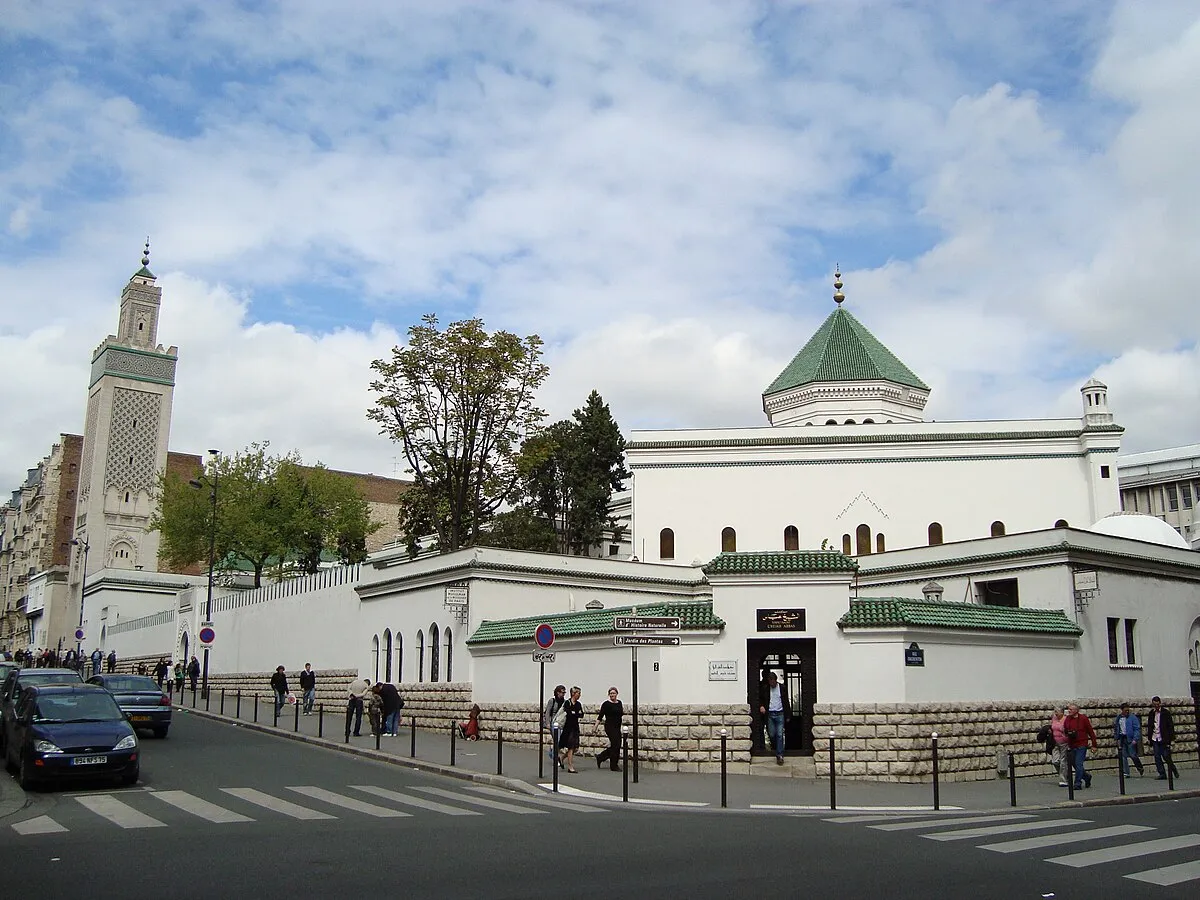
Amidst the bustling Latin Quarter, Paris Great Mosque stands as a tribute to the historical and cultural exchanges that have shaped the city since its construction in the early 20th century.
Built between 1922 and 1926, the mosque was a gesture of gratitude from France to Muslim soldiers from its colonies who fought during World War I. With its striking Hispano-Moorish architecture, the mosque serves as a beacon of Islamic art and tradition in the heart of Paris.
The mosque’s design, inspired by the Alhambra in Granada and the Great Mosque of Fes, features a stunning 33-meter minaret, intricate mosaics, and lush courtyards. The prayer hall, adorned with colorful tiles and beautiful calligraphy, offers a serene space for reflection and worship.
Beyond its religious functions, the mosque houses a library, a hammam (traditional bathhouse), and a traditional North African café, providing visitors a multifaceted cultural experience.
The Paris Great Mosque not only functions as a place of worship but also as a center for interfaith dialogue and cultural understanding. It stands as a symbol of Paris’s rich multicultural fabric, inviting all who seek to explore the city’s diverse historical narratives.
Le Grand Rex
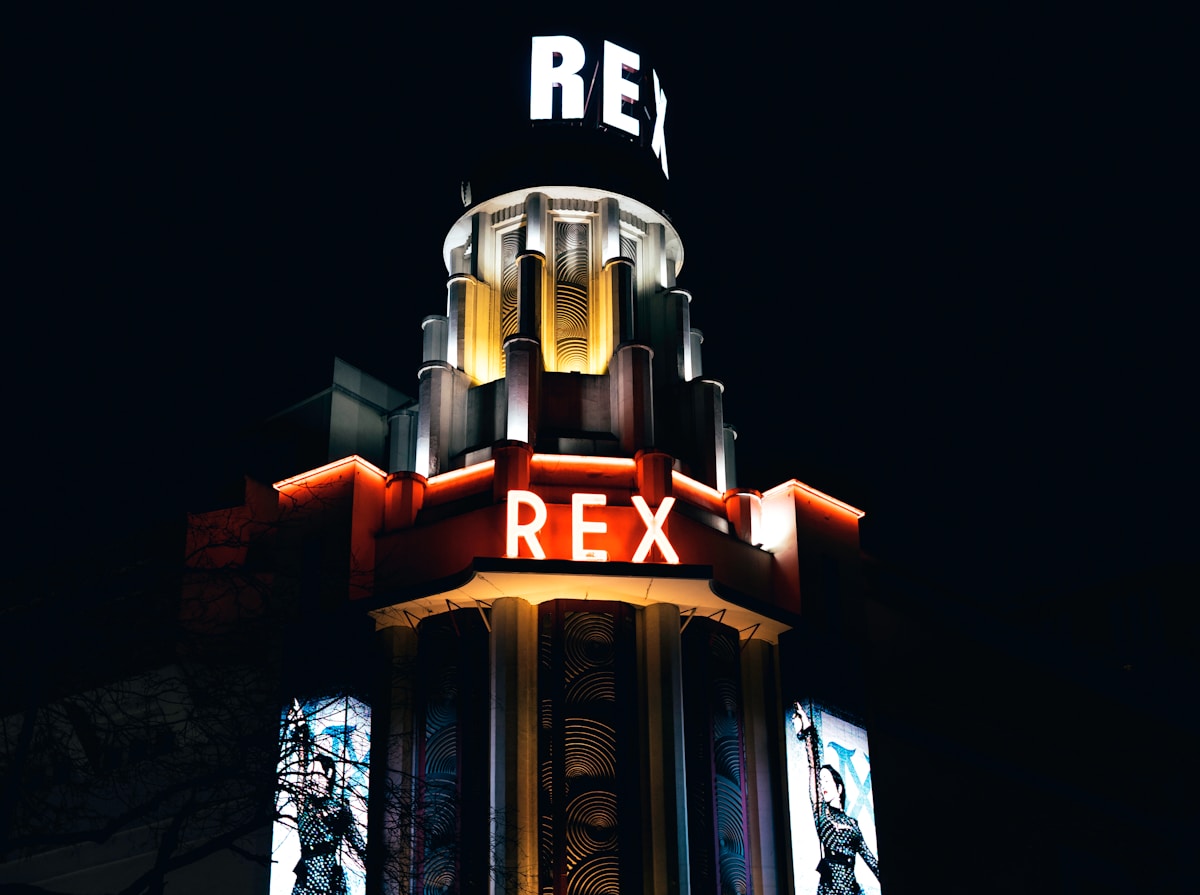
Inaugurated in 1932, Le Grand Rex stands as a tribute to Parisian architectural innovation and the golden age of cinema. Commissioned by film producer Jacques Haïk, this Art Deco masterpiece was designed by architect Auguste Bluysen and engineer John Eberson.
It quickly became Europe’s largest cinema, enchanting audiences with its opulent interiors and advanced technological features.
Le Grand Rex has a storied history that includes hosting premieres of legendary films and performances by iconic artists. Over the decades, it has evolved, embracing new cinematic technologies while preserving its architectural grandeur.
The building’s façade is distinguished by its striking tower, evoking a blend of modernist and classical motifs, which remains an emblem of Parisian cultural heritage.
Visiting Le Grand Rex offers a multifaceted experience:
- Architecture: Marvel at the Art Deco design, including intricate moldings and the iconic starry ceiling.
- History: Learn about its role in cinematic history and its significance during World War II.
- Events in Paris: Attend film premieres, concerts, and special screenings.
- Rex Studios: Explore an interactive museum dedicated to the art of filmmaking.
For those seeking to understand the confluence of art, history, and technology, Le Grand Rex remains an indispensable destination.
Maison de Verre
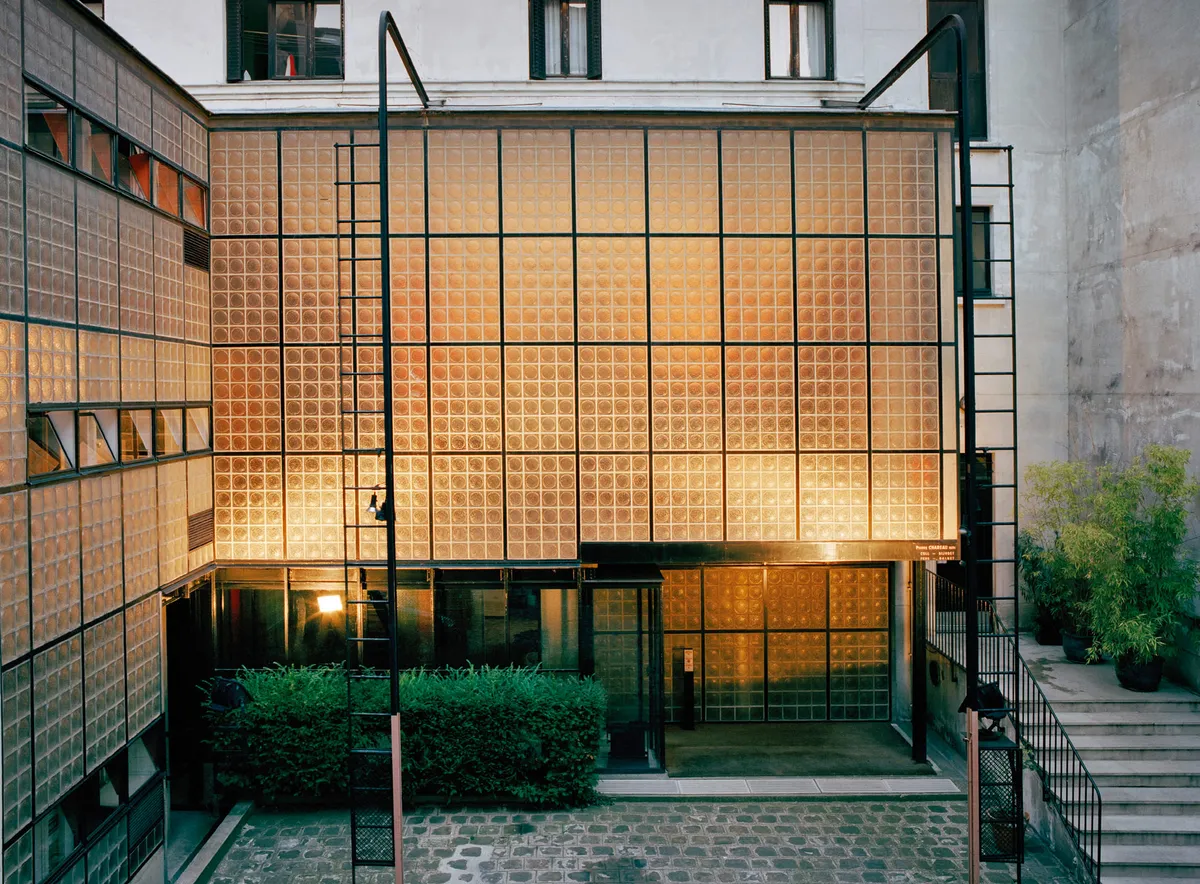
Nestled within the heart of Paris, the Maison de Verre stands as an extraordinary example of modernist architecture, seamlessly juxtaposing the Art Deco opulence of Le Grand Rex with its own industrial elegance and innovative design.
Conceived in the late 1920s by Pierre Chareau, Bernard Bijvoet, and Louis Dalbet, the ‘House of Glass’ reflects a radical departure from traditional architectural norms of its era.
Completed in 1932, the structure epitomizes the avant-garde spirit with its transparent facade composed of glass blocks, steel, and glass, an aesthetic that not only allows for abundant natural light but also signifies transparency and openness.
The Maison de Verre was commissioned by Dr. Jean Dalsace, a progressive gynecologist, and his wife, Annie. Its design intricately blends a medical office on the ground floor with a private residence above, incorporating elements of both functionality and style.
The house’s interior is a masterclass in modular design, featuring movable screens, sliding doors, and exposed mechanical systems that underscore a sense of industrial beauty.
Today, the Maison de Verre remains a pivotal reference point in architectural studies, celebrated for its pioneering integration of modernist principles with practical living spaces.
Centre Pompidou
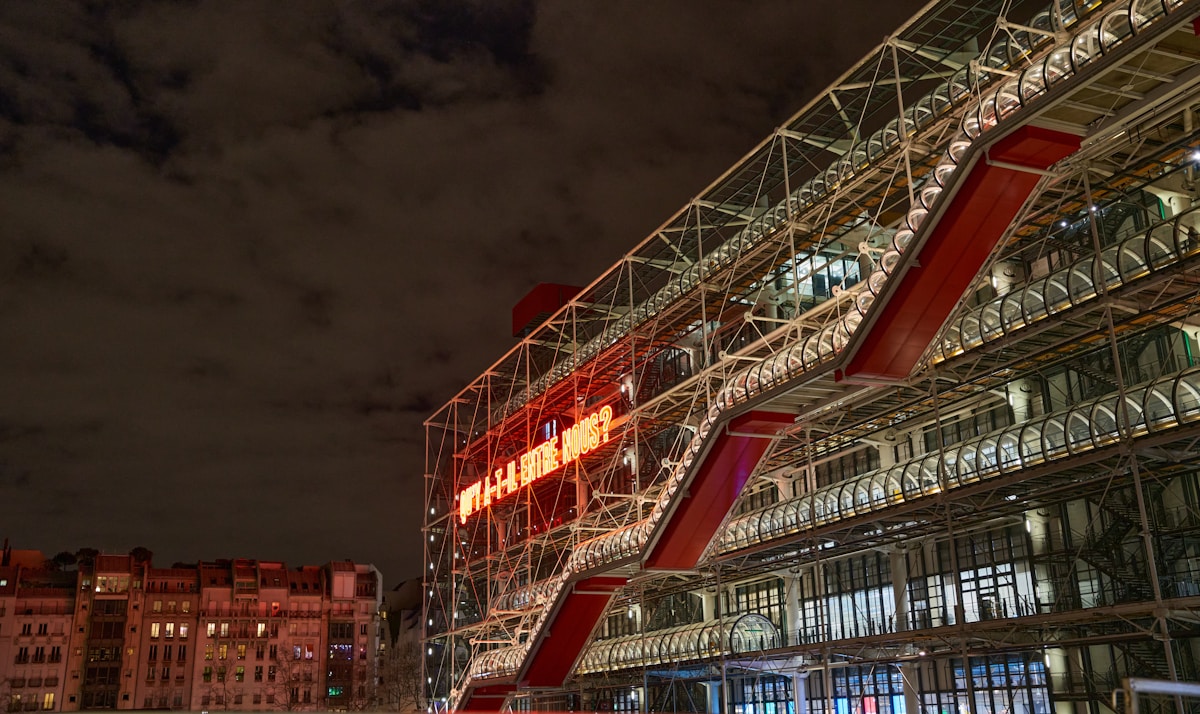
Located in the Beaubourg area of Paris, the Centre Pompidou stands as a revolutionary architectural feat, exemplifying high-tech architecture with its exposed structural elements and vibrant color-coded systems.
Completed in 1977, the building was designed by architects Renzo Piano and Richard Rogers. It broke conventional design norms by placing structural and mechanical systems on the exterior, thereby maximizing interior space. This innovative approach symbolizes the liberation from traditional architectural constraints, offering an open and flexible environment for visitors.
The Centre Pompidou serves multiple cultural purposes, making it a must-visit for anyone exploring Paris.
Key highlights include:
- Modern Art Museum: Housing Europe’s largest collection of modern and contemporary art, featuring works from artists such as Picasso, Kandinsky, and Duchamp.
- Public Library: Serving as a major resource center, it provides access to an extensive collection of books, journals, and multimedia resources.
- Performance Spaces: Hosting a variety of live performances, including theater, dance, and music, which contribute to its dynamic cultural atmosphere.
- Panoramic Views: Offering stunning views of Paris from its rooftop, providing visitors with an unparalleled perspective of the city’s landscape.
Musée d’Orsay
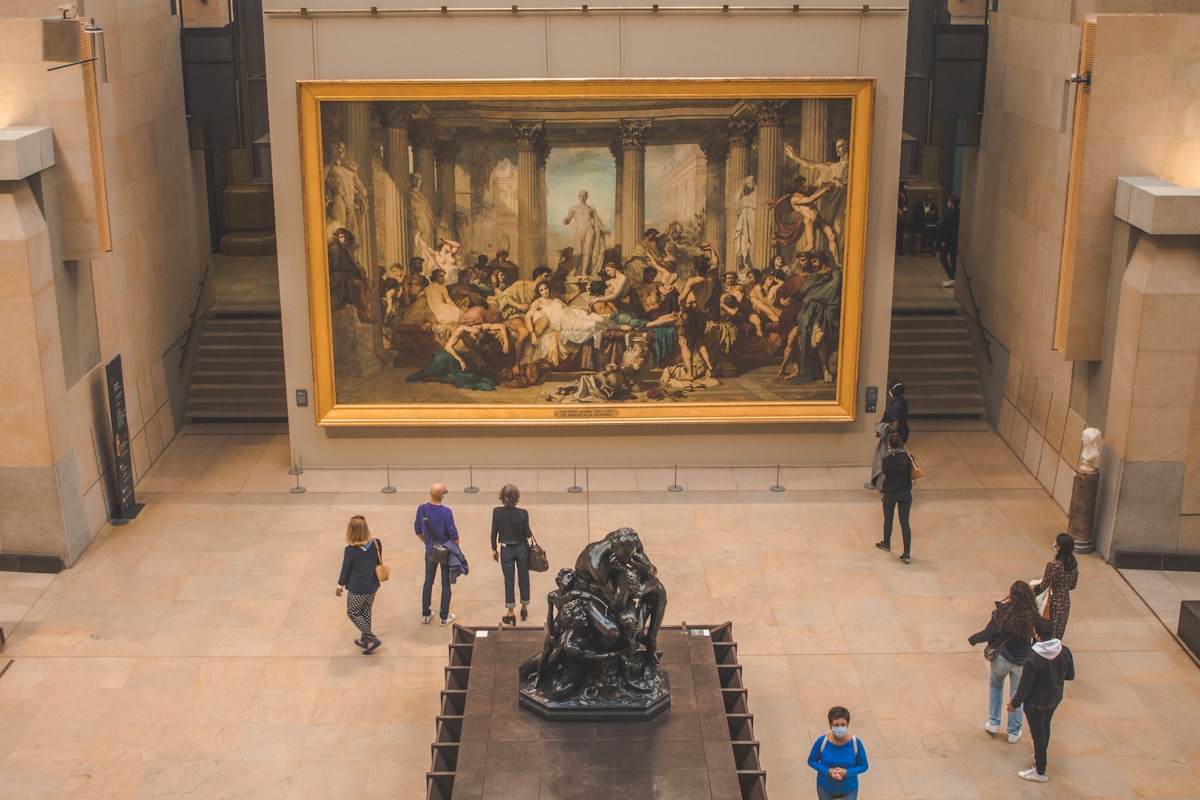
How does one capture the essence of 19th-century artistic innovation and historical transformation in a single location? The answer lies in the Musée d’Orsay, a monumental museum housed in a former railway station, which showcases an extensive collection of impressionist and post-impressionist masterpieces, reflecting the profound cultural shifts of its era.
Originally constructed for the 1900 Exposition Universelle, the Beaux-Arts station’s transformation into a museum in 1986 epitomizes the adaptive reuse of historical architecture.
The Musée d’Orsay’s collection spans from 1848 to 1914, a period marked by rapid industrialization, political upheaval, and artistic experimentation. It hosts seminal works by artists such as Monet, Manet, Degas, Renoir, and Van Gogh, each capturing the zeitgeist of their time through innovative techniques and perspectives.
The museum’s layout offers a chronological journey through artistic movements, providing contextual insights into how socio-economic changes influenced artistic expression.
Visitors can explore the evolution of art against the backdrop of a building that itself is a reflection of historical progress. The Musée d’Orsay not only preserves the past but also invites reflection on the intersection of history, art, and architectural ingenuity, making it an essential destination for those seeking intellectual and aesthetic enrichment in Paris.
Institut du Monde Arabe
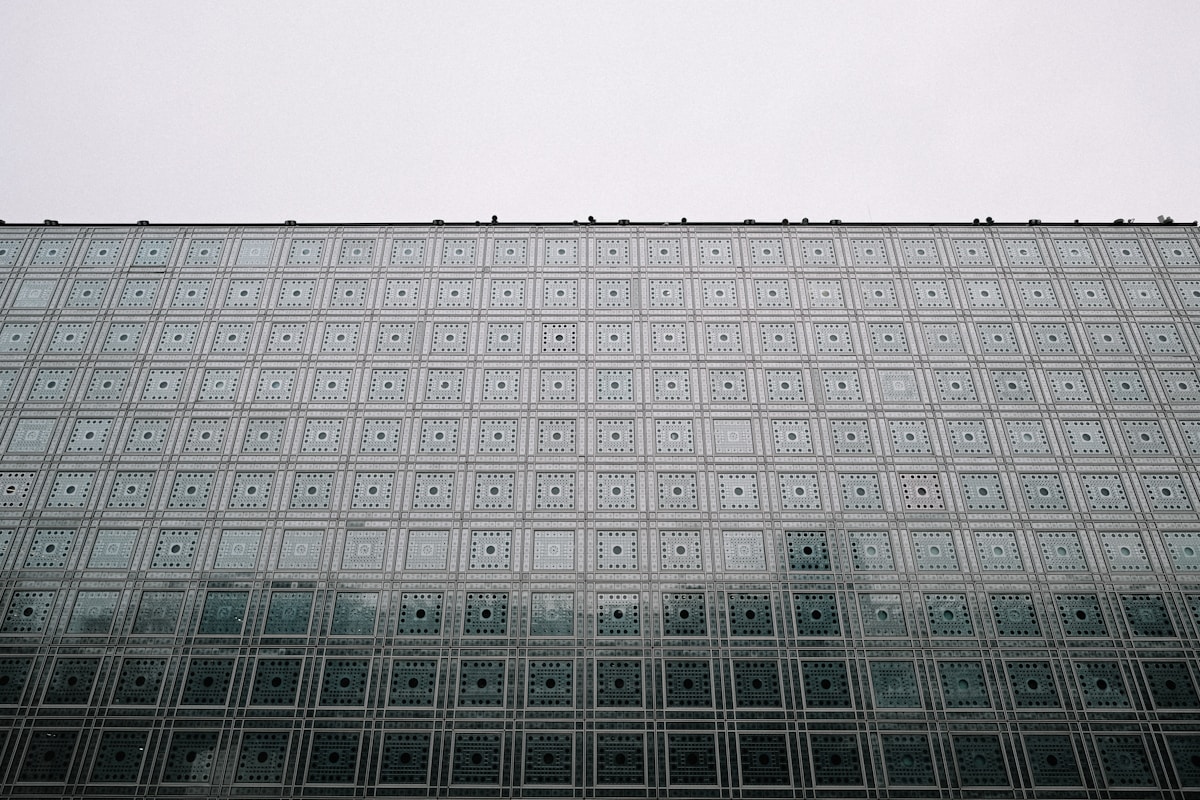
Moving from the artistic innovations of 19th-century France, the Institut du Monde Arabe stands as a tribute to the rich cultural dialogue between France and the Arab world. Founded in 1980, this institution was established to foster understanding and cultural exchange between these two regions.
The building itself, designed by Jean Nouvel, is an architectural marvel that seamlessly integrates traditional Arab motifs with modern design principles.
Noteworthy elements of the Institut du Monde Arabe include:
- Façade with Moucharabieh Windows: These intricate, geometrically patterned windows adjust automatically to control light and heat, reflecting a blend of ancient craftsmanship and contemporary technology.
- Extensive Library: Housing an impressive collection of over 100,000 volumes, it serves as a valuable resource for researchers and enthusiasts of Arab culture and history.
- Exhibitions and Galleries: Regularly hosting temporary exhibitions, the museum offers a dynamic presentation of Arab art, history, and contributions to global culture.
- Panoramic Terrace: Providing stunning views of Paris, this terrace is a favored spot for both tourists and locals, symbolizing the harmonious integration of diverse cultural perspectives.
Pyramide, Le Grand Louvre
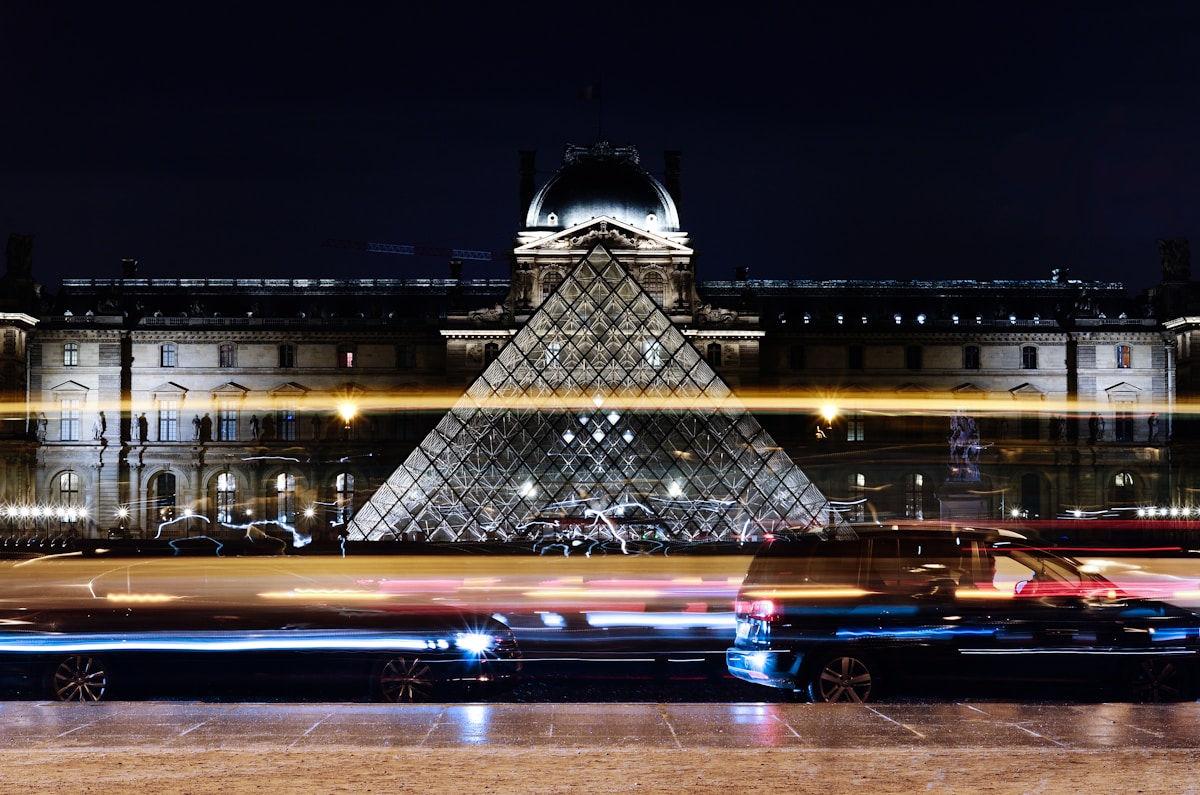
Rising prominently in the courtyard of the Louvre Museum, the iconic glass pyramid designed by architect I. M. Pei stands as a symbol to the harmonious blend of historical grandeur and modern innovation in Paris. This architectural marvel, inaugurated in 1989, serves as the main entrance to the museum and has become an emblematic feature of the city.
Pei’s design faced initial controversy, with critics arguing that a modern glass structure would clash with the classical architecture of the former royal palace. However, the pyramid now draws universal acclaim, seamlessly merging with the Louvre’s facade and enhancing its historical context.
The pyramid, composed of 673 panes of glass, not only provides a striking visual contrast but also optimizes the flow of natural light into the subterranean lobby. This innovative approach enhances the visitor experience, creating an inviting and luminous entryway to one of the world’s most renowned art institutions.
The structure’s precise alignment with the Louvre’s historical axis underscores the meticulous planning that went into its creation. Today, the Pyramide du Louvre is not merely an entrance but a representation of Paris’s ability to evolve while respecting its rich heritage, embodying the spirit of freedom and artistic expression.
Opéra de la Bastille
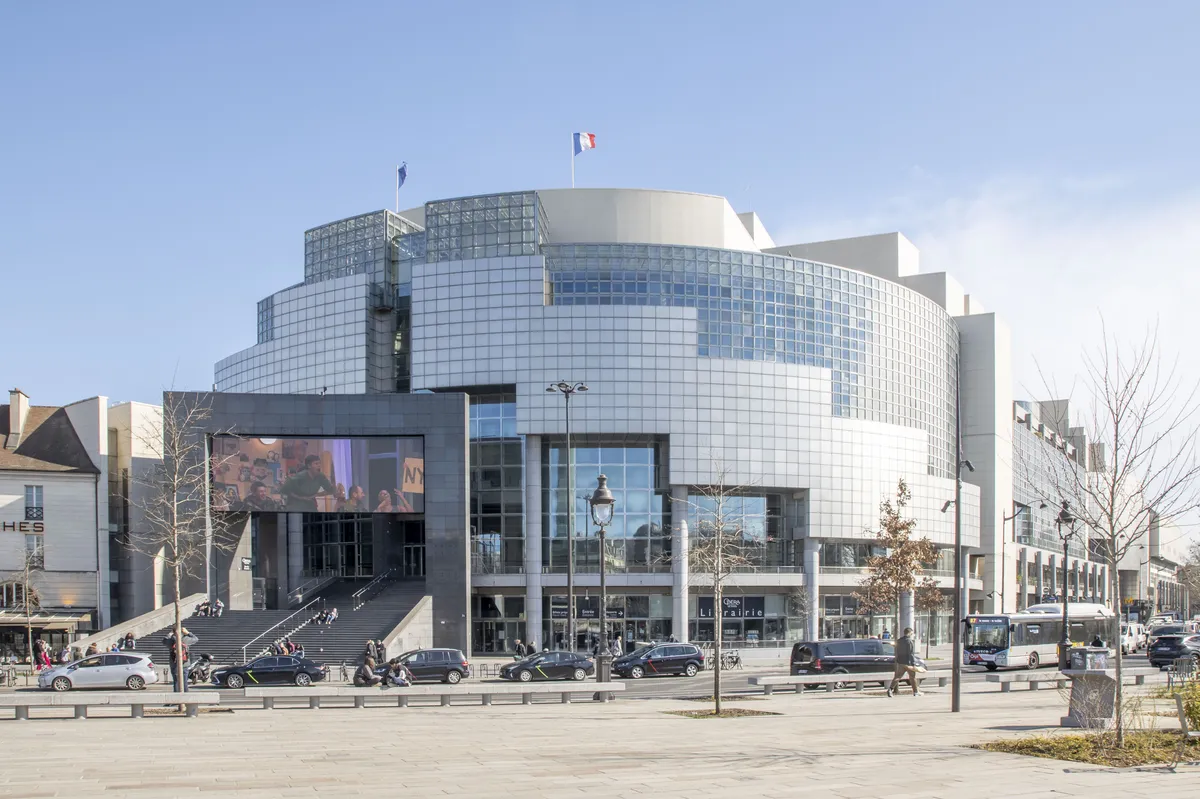
The Opéra de la Bastille, inaugurated on July 13, 1989, stands as a tribute to modern architectural ingenuity and cultural ambition, marking a significant chapter in Paris’s storied history of performing arts. Located at the Place de la Bastille, this opera house was designed by the Canadian-Uruguayan architect Carlos Ott.
As the main venue for the Paris National Opera, it complements the historic Palais Garnier, blending contemporary aesthetics with traditional operatic grandeur.
The Opéra de la Bastille serves as a beacon of innovation and accessibility, with features designed to democratize the opera-going experience:
- Seating Capacity: The house boasts 2,745 seats, ensuring that a broad audience can experience high-quality performances.
- Acoustic Excellence: Advanced acoustic engineering provides an unparalleled auditory experience, critical for both performers and audiences.
- Modern Facilities: It includes state-of-the-art stage technology, enhancing the production capabilities for elaborate operas and ballets.
- Accessibility: The design incorporates accessibility features, making it a welcoming space for all patrons.
Inaugurated on the bicentennial of the French Revolution, the Opéra de la Bastille symbolizes the enduring spirit of cultural progress and artistic freedom, solidifying its status as a must-visit landmark in Paris.
La Grande Arche de la Défense

Located in the heart of Paris’s modern business district, La Grande Arche de la Défense serves as a striking symbol of contemporary architectural vision and historical continuity.
Conceived as a 20th-century counterpoint to the Arc de Triomphe, this monumental structure was inaugurated in 1989 to mark the bicentennial of the French Revolution. Designed by Danish architect Johan Otto von Spreckelsen, La Grande Arche exemplifies the minimalist International Style, with its clean lines and geometric precision.
Standing at a height of 110 meters, the structure forms a perfect cube adorned with white Carrara marble and glass, offering a stark contrast to the classical facades of central Paris. The Grande Arche not only embodies modernity but also aligns perfectly with the historical Axe Historique, a line of monuments that stretches from the Louvre to the outskirts of the city.
Functionally, the Grande Arche houses government offices, exhibition spaces, and a rooftop terrace, providing panoramic views of Paris. Its design reflects a philosophical alignment with transparency, openness, and the democratic ideals of the French Republic.
For visitors, the Grande Arche is more than just an architectural marvel; it is a reflection of the enduring dialogue between past and future.
Bibliothèque François-Mitterrand

Among the essential landmarks in Paris, the Bibliothèque François-Mitterrand stands as a tribute to modern architectural ingenuity and the city’s commitment to cultural preservation.
Established in 1996, this library is named after the former French President François Mitterrand, who championed its creation as part of his ‘Grands Projets’ to endow Paris with monumental architecture.
The library’s design, conceived by architect Dominique Perrault, is characterized by four L-shaped towers resembling open books, symbolizing the dissemination of knowledge.
The Bibliothèque François-Mitterrand is not just an architectural marvel but also a cornerstone of French literary heritage. It serves as the main repository for France’s national library holdings and offers a vast collection of works. Visitors and scholars alike are drawn to its extensive resources and modern amenities.
Key features of the library include:
- Collections: Over 14 million books and documents, including rare manuscripts.
- Research Facilities: Advanced amenities for academic research and study.
- Cultural Events: Hosts exhibitions, lectures, and cultural programs.
- Eco-Friendly Design: Incorporates sustainable architecture and green spaces.
In essence, the Bibliothèque François-Mitterrand encapsulates the blend of Paris’s historical depth and its forward-looking vision, making it a must-visit landmark for those seeking intellectual and cultural enrichment.
Flower Tower
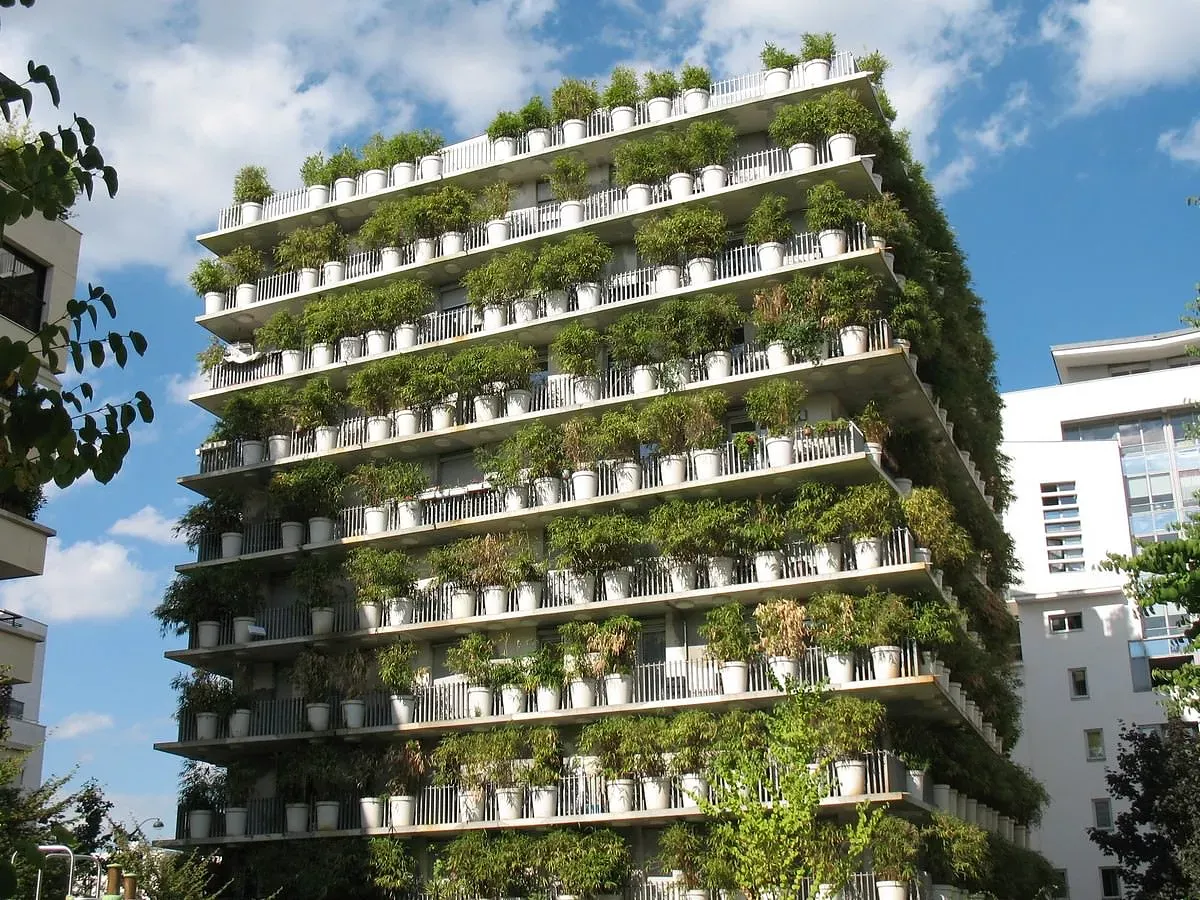
One of the most innovative examples of contemporary architecture in Paris, the Flower Tower exemplifies the seamless integration of nature and urban design.
Conceptualized by architect Edouard François in 2004 and completed in 2009, this residential building stands out for its unique facade enveloped in lush greenery.
Each balcony is adorned with bamboo plants, creating a vertical garden that not only enhances the aesthetic appeal but also contributes to environmental sustainability.
Strategically located in the 17th arrondissement, near the Porte d’Asnières, the Flower Tower represents a significant departure from traditional Parisian architecture.
Its design is grounded in the principles of biophilic design, aiming to foster a connection between residents and nature. The bamboo plants, housed in pre-fabricated concrete planters, act as natural air filters, improving the quality of life for inhabitants.
The building’s innovative design has garnered international acclaim, establishing it as a symbol of modern urban living. The Flower Tower’s symbiotic relationship between architecture and nature serves as an inspiring model for future urban developments.
For those seeking to experience Paris’s bold strides in contemporary sustainability, the Flower Tower is an essential visit.
Quai Branly Museum

Showcasing a remarkable collection of indigenous art and cultures from Africa, Asia, Oceania, and the Americas, the Quai Branly Museum stands as a tribute to France’s commitment to cultural preservation and global heritage.
Inaugurated in 2006, this museum, designed by architect Jean Nouvel, serves as a beacon of intercultural dialogue and understanding, embodying the ethos of cultural inclusivity.
The museum’s extensive collection spans centuries and continents, offering visitors an immersive glimpse into the artistic and cultural contributions of non-European societies.
Key features of the museum include:
- Permanent Collections: Over 300,000 artifacts, ranging from textiles and musical instruments to ceremonial objects and sculptures.
- Temporary Exhibitions: Regularly changing exhibits that explore specific cultural themes or regions, providing fresh perspectives.
- Multimedia Installations: Interactive displays and digital guides that enhance the visitor experience by providing contextual information and engaging narratives.
- Lush Gardens: Designed by landscape architect Gilles Clément, these gardens offer a serene escape, connecting the museum’s architecture with nature.
The Quai Branly Museum epitomizes a modern approach to museum curation by celebrating diversity and fostering a deeper understanding of the world’s rich and varied cultural landscapes.
It is undeniably a must-visit landmark for anyone exploring Paris.
Fondation Louis Vuitton
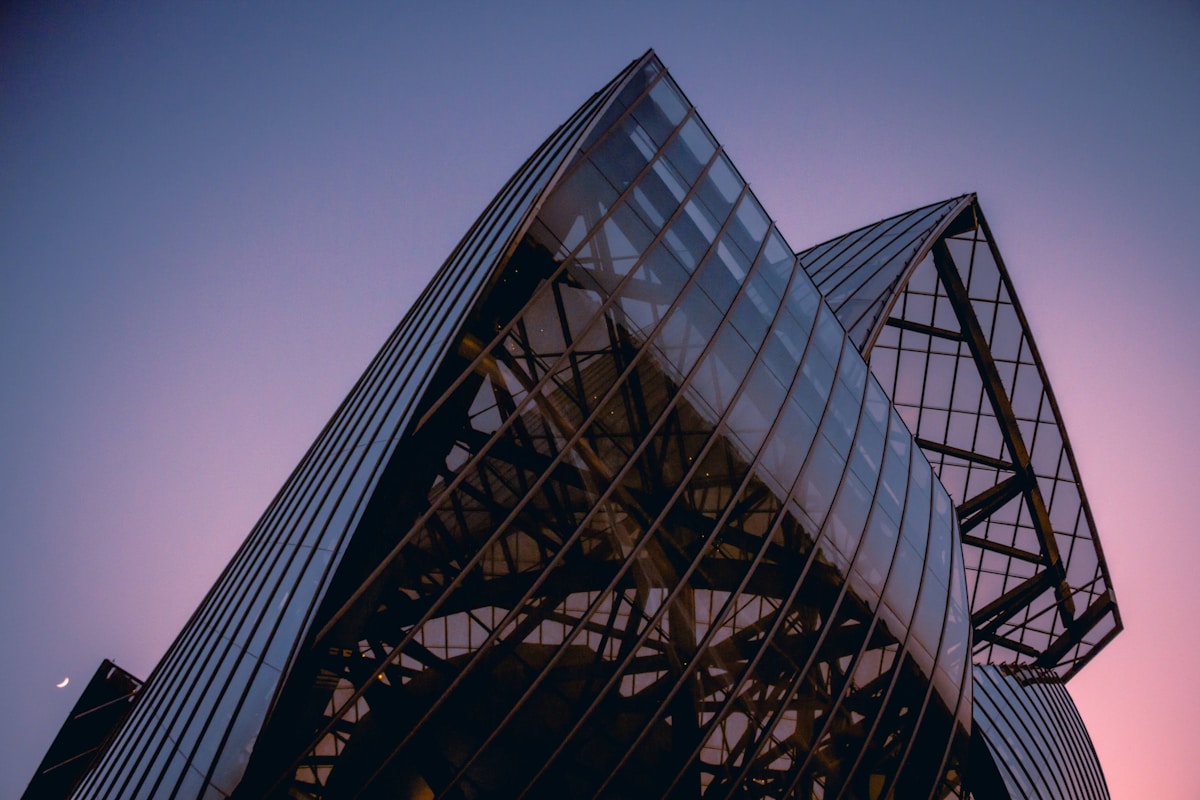
Nestled within the verdant Bois de Boulogne, the Fondation Louis Vuitton, inaugurated in 2014, stands as a tribute to contemporary art and architectural innovation in Paris.
Designed by the visionary architect Frank Gehry, this monumental structure is a masterpiece of modern engineering and artistic expression. Its distinctive glass sails, which seem to float effortlessly above the trees, are both a nod to the maritime spirit and a bold statement of modern creativity.
The Fondation’s mission is to promote art and culture, providing a dynamic space for exhibitions, concerts, and events. Its collections are a reflection of the evolution of contemporary art, featuring works by renowned artists such as Jean-Michel Basquiat, Gerhard Richter, and Olafur Eliasson.
The architectural design itself is an ever-evolving canvas, with its reflective surfaces and light-filled interiors creating a dialogue between nature and structure.
The Fondation Louis Vuitton is not merely a museum but a cultural beacon, drawing visitors from around the globe. It embodies the spirit of innovation and freedom, making it an essential landmark for anyone looking to explore the artistic and historical depths of Paris.

